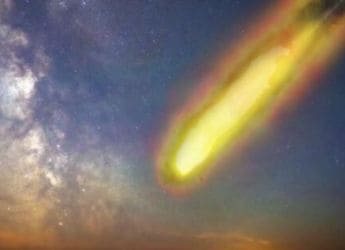- Home
- Science
- Science News
- Study Links Microbial Colonization to Ancient Meteorite Crater: What You Need to Know
Study Links Microbial Colonization to Ancient Meteorite Crater: What You Need to Know
Scientists traced microbial life in Finland’s 78M-year-old Lappajärvi crater to just 4–5 million years after impact, using isotopic signatures of sulfate- and methane-cycling bacteria.

Photo Credit: Linnaeus University
Microbial life re-established itself in an ancient meteorite crater
Scientists have, for the first time, precisely dated when microbial life re-established itself in an ancient meteorite crater. A team at Linnaeus University in Sweden found chemical evidence that bacteria colonized the 78-million-year-old Lappajärvi crater in western Finland soon after a meteorite impact created it. Using radioisotope dating of mineral-rich deposits, the researchers show these microbes thrived in the crater's fractured hydrothermal system. The finding suggests that even meteorite impacts can create long-lived habitats for life. The study is published in Nature Communications.
Life in the Lappajärvi Crater
According to the study, using radiometric dating and isotopic analysis, the team established a timeline for the crater's biosphere. They dated mineral veins to about 73.6 million years ago (roughly 4–5 Myr after impact), when the subsurface had cooled to ~47 °C. These veins include pyrite (iron sulfide) crystals with unusually low levels of the heavy sulfur-34 isotope – a hallmark of microbial sulfate reduction. About 10 Myr after impact, later minerals contained isotopic clues to microbial methane cycling. Together, the chemical signatures confirm a deep microbial ecosystem thriving in the cooling crater long after the collision.
New direction in astrobiology research
According to the team, the results open a new window in astrobiology. Lead author Henrik Drake notes this provides the first geochronological link between microbes and an impact event, showing craters can remain habitable long after they form. Co-author Gordon Osinski adds that earlier evidence only hinted at crater life, but this study pins down exactly when it occurred. The researchers also point out that similar hydrothermal craters on Mars, Europa or other worlds might likewise harbor life. In other words, a planet's violent impact history could paradoxically foster life over the long term.
For the latest tech news and reviews, follow Gadgets 360 on X, Facebook, WhatsApp, Threads and Google News. For the latest videos on gadgets and tech, subscribe to our YouTube channel. If you want to know everything about top influencers, follow our in-house Who'sThat360 on Instagram and YouTube.
Related Stories
- Samsung Galaxy Unpacked 2025
- ChatGPT
- Redmi Note 14 Pro+
- iPhone 16
- Apple Vision Pro
- Oneplus 12
- OnePlus Nord CE 3 Lite 5G
- iPhone 13
- Xiaomi 14 Pro
- Oppo Find N3
- Tecno Spark Go (2023)
- Realme V30
- Best Phones Under 25000
- Samsung Galaxy S24 Series
- Cryptocurrency
- iQoo 12
- Samsung Galaxy S24 Ultra
- Giottus
- Samsung Galaxy Z Flip 5
- Apple 'Scary Fast'
- Housefull 5
- GoPro Hero 12 Black Review
- Invincible Season 2
- JioGlass
- HD Ready TV
- Laptop Under 50000
- Smartwatch Under 10000
- Latest Mobile Phones
- Compare Phones
- Samsung Galaxy A17 4G
- Redmi 15C 5G
- Oppo K13s
- Redmi 15R 5G
- Vivo Y31 Pro 5G
- Vivo Y31 5G
- Oppo F31 5G
- Oppo F31 Pro 5G
- Acer Nitro V 16S (2025)
- Acer Nitro V 16 (2025)
- Moto Pad 60 Neo
- Xiaomi Moaan InkPalm Mini Plus 2
- Garmin Instinct Crossover AMOLED
- Garmin Venu 4
- Elista QLED Google TV
- TCL C72K QD Mini‑LED TV
- Asus ROG Ally
- Nintendo Switch Lite
- Haier 1.6 Ton 5 Star Inverter Split AC (HSU19G-MZAID5BN-INV)
- Haier 1.6 Ton 5 Star Inverter Split AC (HSU19G-MZAIM5BN-INV)














